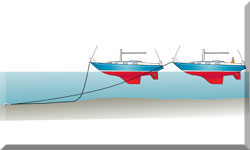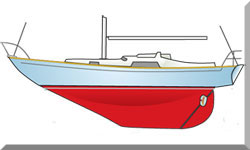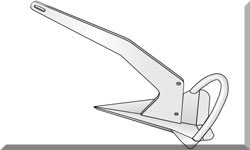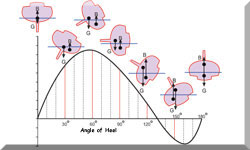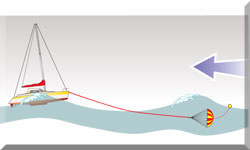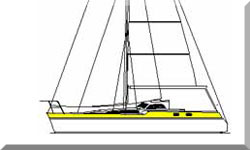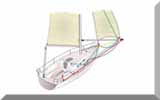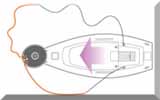- Home
- Marine Electrical Systems
- Sizing 12V Battery Bank
Sizing Your 12V Battery Bank: A Step-by-Step Guide
In a Nutshell...
Sizing your boat's 12V battery bank is all about getting the balance right between what your electrical systems need and what your batteries can supply. It's not just about adding up the numbers; you need to factor in things like how fast you discharge the batteries, their amp-hour rating, and the efficiency of your charging system. Getting this right means you'll have enough power without needlessly lugging around extra weight, and you'll protect your batteries from premature failure. It’s a key part of setting up a reliable marine electrical system.
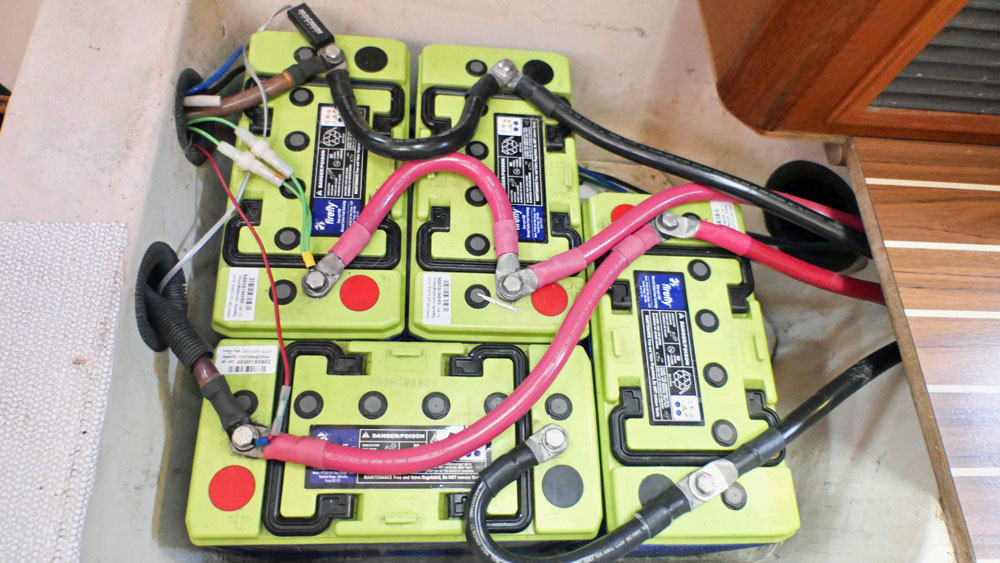 A 420AH domestic battery bank, but each battery should be securely strapped down.
A 420AH domestic battery bank, but each battery should be securely strapped down.Table of Contents
It’s often said that a boat is just a hole in the water you throw money into. As an experienced ocean sailor, I’d add that it's also a power-hungry beast, especially with all the modern electronics we've come to rely on. From navigation instruments to fridges, they all need juice, and that’s where your 12V domestic battery bank comes in. Think of it as your onboard energy reservoir, separate from your engine's dedicated starter battery. Getting the size of your domestic bank right is crucial for a peaceful voyage—no one wants to listen to a noisy engine just to charge their batteries.
The Energy Equation: Demand vs. Supply
At its core, your boat’s electrical system is a simple equation:
Energy In = Energy Out
You can only take out what you put in. Over time, that balance needs to be managed properly. The whole system—from your power generation (engine alternator, solar panels, wind generator) to your storage (the batteries) and the demand from your appliances—has to work in harmony. If the supply can't keep up with the demand, you'll find yourself with flat batteries and, eventually, a useless bank.
To get a handle on this, we need to look at both sides of the equation.
- The 'Demand' side: How much energy do all your systems and appliances consume?
- The 'Supply' side: How can we generate and store enough energy to meet that requirement?
Understanding Battery Amp-Hour Ratings
Before we get into the calculations, let’s clear up a common misunderstanding about battery ratings. Battery capacity is measured in amp-hours (Ah), but this number isn't a fixed value. It's always tied to a specific discharge rate, most commonly a 10-hour or 20-hour rate.
A battery rated at 100Ah at a 10-hour rate means it can deliver 10 amps for 10 hours. A battery rated at 100Ah at a 20-hour rate can deliver 5 amps for 20 hours. But here’s the kicker: the faster you discharge a battery, the less total capacity you get out of it. It might seem counter-intuitive, but a 100Ah battery rated at a 10-hour rate actually has more usable capacity than one with the same rating at a 20-hour rate.
The good news is that the converse is also true. If you discharge your batteries at a slower rate than their nominal rating, you'll actually get more amp-hours out of them. It's a key factor to remember when you're calculating your total energy needs.
How to Calculate Your Battery Bank Size
The first step in sizing your battery bank is to figure out your total daily amp-hour consumption. As a sailor, I usually do this for a typical 24-hour period while anchored, as this is when the engine is most likely to be off.
Step 1: List Your Appliances & Their Draw
Create a table of every electrical appliance you use, how many amps it draws, and for how many hours a day you use it. For example:
| Appliance | Amps (A) | Hours/Day | Total Ah/Day |
|---|---|---|---|
| Navigation Lights | 2.0 | 6 | 12.0 |
| LED Cabin Lights | 0.5 | 4 | 2.0 |
| Fridge | 4.0 | 8 (duty cycle) | 32.0 |
| Laptop Charging | 3.0 | 2 | 6.0 |
| VHF Radio (Standby) | 0.5 | 24 | 12.0 |
| Autopilot | 5.0 | 4 | 20.0 |
| Total Daily Consumption | 84.0 |
Step 2: Calculate Your Required Battery Capacity
Once you have your total daily consumption, you need to size your battery bank to meet that demand—with a crucial safety margin. Most experts, including myself, recommend only discharging your lead-acid batteries to 50% of their total capacity to avoid sulphation and premature failure.
So, if your total daily consumption is 84Ah, you need a battery bank with a total capacity of at least 168Ah (84Ah ÷ 0.5 = 168Ah). This gives you a two-day buffer without needing to recharge, which is a sensible approach for cruising.
The Daily Current Draw Calculator
When I did all this number crunching for my own boat, I put together a live spreadsheet which enabled me to see the effect of switching various electrical items on/off, and varying the periods of their use, during each of these scenarios:
- Underway during daylight hours;
- Underway at night;
- At anchor during daylight hours, and
- At anchor at night.
It enables you to see which scenario is the most costly in terms of amp-hours, and of course it's that scenario upon which you should size your 12v domestic battery bank.
For the princely sum of $4.99 you can download my Daily Current Draw Calculator here. It will save you a lot of work and lighten your darkness—and to sweeten the pill it comes with a free gift which I'm sure you'll enjoy...
Sizing for the Real World
In an ideal world, a 168Ah battery bank would be all you need. However, the reality on a boat is a little different. Standard alternators on most yacht engines don't fully charge your batteries, often only getting them to about 70%. This means you're already starting with a deficit.
Let's use a real-world scenario:
If your daily draw is 175Ah over a 12-hour period, you might think a 350Ah battery bank is enough. On paper, it is. But because of the charging inefficiencies and the fact that you want to avoid draining the batteries too deeply, you need to build in more capacity. You'll also lose about 10% of your capacity over time due to sulphation if your batteries aren't fully charged regularly.
A better approach is to use the next size up. Instead of a bare minimum, consider installing two 200Ah marine batteries, giving you a total of 400Ah. This extra capacity provides a vital buffer. It ensures you have power for longer periods without needing to run the engine, and it helps maintain the health of your batteries by keeping them in a more favourable state of charge.
Beyond the Alternator: The Complete Charging System
While an engine's alternator is a crucial part of your electrical system, it's rarely enough to keep a large domestic bank fully charged on its own. For many sailors, especially those who prefer quiet anchorages over running the engine, a more complete charging system is essential. You can supplement your power with silent, renewable sources like solar panels, which are a brilliant way to top up your batteries during the day. Another option is a wind generator, which works round the clock whenever there's a breeze. For longer-term power when you're in a marina, a dedicated shore power charger is an efficient way to fully replenish your batteries. This comprehensive approach ensures you always have a way to meet your energy demands, regardless of whether you're under way or at anchor.
To get a full understanding of how these components fit together, and for more detailed information on other key electrical systems, check out our comprehensive guide on Marine Electrical Systems: A Sailor's Guide to 12V Electrics.
Keeping a Watchful Eye: Monitoring Your Battery Bank
Simply checking the voltage on your batteries won't give you the full picture of their health. While an open-circuit voltage is a good indicator of a battery's state of charge, but only after it has stabilised for a few hours with no loads on it. If you measure it right after charging, you might see a high voltage (up to 13.4V) due to "surface charge." To get a true reading, apply a small load (like a cabin light) for about ten minutes to bleed off this surface charge.
Here's a quick reference for a battery's state of charge based on its open-circuit voltage:
- 12.8V: Fully charged
- 12.6V: 80% charged
- 12.4V: 70% charged
- 12.2V: 50% charged
- 12.0V: 30% charged
- 11.8V: Completely discharged (you don't want to get here!)
Discharging your batteries below 50% can cause permanent damage, significantly shortening their lifespan. The most accurate way to monitor your power is with a dedicated battery monitor that tracks amp-hours in and out, giving you a precise "fuel gauge" for your bank. By sizing your bank correctly and actively monitoring your power usage, you can keep your batteries happy and extend their life for many years.
Summing Up
Sizing your boat’s 12V domestic battery bank isn't just a simple calculation; it's a careful balance of energy consumption, battery characteristics, and charging efficiency. By accurately assessing your daily energy needs and building in a healthy buffer, you can create a reliable marine electrical system that provides consistent power, protects your valuable batteries, and ensures a more peaceful, engine-off experience at anchor. Don't skimp on capacity—it's one of the best investments you can make for your boat and your sanity.
This article was written by Dick McClary, RYA Yachtmaster and author of the RYA publications 'Offshore Sailing' and 'Fishing Afloat', member of The Yachting Journalists Association (YJA), and erstwhile member of the Ocean Cruising Club (OCC).
FAQs
Q: How do I know the amp draw of my appliances?
Q: How do I know the amp draw of my appliances?
A: You can often find this information in the appliance's manual or on a label. If not, you can use a multimeter with a clamp-on ammeter to measure the current draw directly.
Q: Can I mix different types of batteries in my bank?
Q: Can I mix different types of batteries in my bank?
A: No, it is generally not recommended to mix batteries of different ages, sizes, or types (e.g., lead-acid, AGM, lithium). This can lead to uneven charging and discharging, reducing the overall lifespan of the bank.
Q: What is the difference between a starter battery and a domestic battery bank?
Q: What is the difference between a starter battery and a domestic battery bank?
A: A starter battery is designed to deliver a large, short burst of current to start an engine, while a domestic, or "deep-cycle," battery is built to provide a steady, lower current over a longer period and can withstand repeated deep discharges without damage. A key part of good boat management is keeping these banks separate. However, in a dire emergency, many sailors have a switch that can temporarily parallel the two banks to provide enough power to start the engine if the starter battery is flat.
Q: How often should I fully charge my domestic battery bank?
Q: How often should I fully charge my domestic battery bank?
A: To maximise lifespan, you should aim to fully charge your battery bank as often as possible. Ideally, this should be done daily, but at least once every few days to prevent sulphation.
Q: Is it better to have one large battery or multiple smaller ones?
Q: Is it better to have one large battery or multiple smaller ones?
A: Multiple smaller batteries can be a good option as they offer redundancy. If one battery fails, the others can still provide power. However, they need to be identical and wired correctly to ensure balanced charging and discharging.
Recent Articles
-
Hans Christian 43: Classic Bluewater Cruiser & Liveaboard Sailboat
Dec 10, 25 04:37 AM
Explore the Hans Christian 43: a legendary heavy-displacement, long-keel sailboat. Read our in-depth review of its specs, design ratios, and suitability for offshore cruising and living aboard. -
Planning Your Sailboat Liveaboard Lifestyle: An Ocean Sailor's Guide
Dec 06, 25 05:18 AM
Seasoned sailors share their methodical risk analysis for planning a secure Sailboat Liveaboard Lifestyle, covering financial, property, and relationship risks. -
Marine Cabin Heaters: The Expert’s Guide to Comfort & Safety at Sea
Dec 05, 25 06:52 AM
Choose the best Marine Cabin Heaters for your vessel. Expert advice on diesel, paraffin, and hot water systems for year-round cruising comfort.

